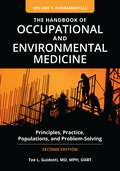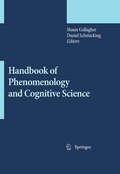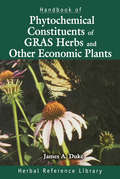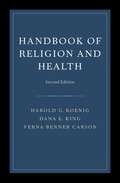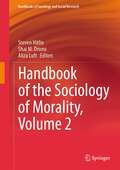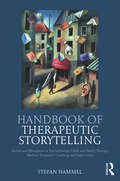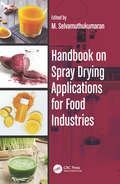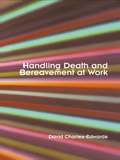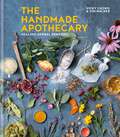- Table View
- List View
The Handbook of Occupational and Environmental Medicine [2 volumes]: Principles, Practice, Populations, and Problem-Solving [2 volumes]
by Tee L. GuidottiProvides health professionals with a single, accessible, and interesting source to prepare for the field of occupational and environmental medicine. The new edition is extensively updated and includes questions for review in preparation for taking exams.This set is designed to be a thorough introduction for physicians entering the occupational and environmental medicine field, whether preparing for specialty examinations or moving into the field from other medical specialties or from primary care. It also serves as a convenient guide and reference for nurses, health professionals, and those outside of health care who need a quick orientation. The set is written with a strong and coherent point of view about the value of occupational and environmental medicine and commitment to ethical, worker-centered practice. It is unusual in the depth of its coverage; its inclusion of important topics that are usually overlooked in textbooks of the field, such as risk science; its emphasis on good management of occupational health services; and its thorough integration of material that fits topics together rather than presenting them as if they were separate and unrelated.
The Handbook of Occupational and Environmental Medicine [2 volumes]: Principles, Practice, Populations, and Problem-Solving [2 volumes]
by Tee L. GuidottiProvides health professionals with a single, accessible, and interesting source to prepare for the field of occupational and environmental medicine. The new edition is extensively updated and includes questions for review in preparation for taking exams.This set is designed to be a thorough introduction for physicians entering the occupational and environmental medicine field, whether preparing for specialty examinations or moving into the field from other medical specialties or from primary care. It also serves as a convenient guide and reference for nurses, health professionals, and those outside of health care who need a quick orientation. The set is written with a strong and coherent point of view about the value of occupational and environmental medicine and commitment to ethical, worker-centered practice. It is unusual in the depth of its coverage; its inclusion of important topics that are usually overlooked in textbooks of the field, such as risk science; its emphasis on good management of occupational health services; and its thorough integration of material that fits topics together rather than presenting them as if they were separate and unrelated.
Handbook of Peripheral Neuropathy
by Mark B. Bromberg A. Gordon SmithProviding a detailed study of the anatomy, physiology, and pathology of peripheral nerves, this reference provides a clear approach to the evaluation, characterization, and treatment of peripheral neuropathies-reviewing each major class of these disorders with authoritative discussions of clinical characteristics, electrodiagnostic features, examin
Handbook of Phenomenology and Cognitive Science
by Shaun Gallagher Daniel SchmickingThis volume explores the essential issues involved in bringing phenomenology together with the cognitive sciences, and provides some examples of research located at the intersection of these disciplines. The topics addressed here cover a lot of ground, including questions about naturalizing phenomenology, the precise methods of phenomenology and how they can be used in the empirical cognitive sciences, specific analyses of perception, attention, emotion, imagination, embodied movement, action and agency, representation and cognition, inters- jectivity, language and metaphor. In addition there are chapters that focus on empirical experiments involving psychophysics, perception, and neuro- and psychopathologies. The idea that phenomenology, understood as a philosophical approach taken by thinkers like Husserl, Heidegger, Sartre, Merleau-Ponty, and others, can offer a positive contribution to the cognitive sciences is a relatively recent idea. Prior to the 1990s, phenomenology was employed in a critique of the first wave of cognitivist and computational approaches to the mind (see Dreyfus 1972). What some consider a second wave in cognitive science, with emphasis on connectionism and neuros- ence, opened up possibilities for phenomenological intervention in a more positive way, resulting in proposals like neurophenomenology (Varela 1996). Thus, bra- imaging technologies can turn to phenomenological insights to guide experimen- tion (see, e. g. , Jack and Roepstorff 2003; Gallagher and Zahavi 2008).
Handbook of Phytochemical Constituent Grass, Herbs and Other Economic Plants: Herbal Reference Library
by James A. DukeCRC Handbook of Phytochemical Constituents of GRAS Herbs and Other Economic Plants is a unique catalog that includes more than 15,000 phytochemical constituents from over 1,000 higher plant species. This volume covers all of the generally-recognized-as-safe (GRAS) herbs and at least 250 important food and medicinal plants. Each entry features the scientific name, one or more common names, a listing of phytochemical constituents, a single datum or range of quantitative data (wet-weight to dry-weight in parts per million), two-letter abbreviation identifying the plant part, and three-letter abbreviation(s) indicating the source(s) of the data. The extraordinary amount of data compiled into an easy-to-use tabular format makes the CRC Handbook of Phytochemical Constituents of GRAS Herbs and Other Economic Plants a volume useful to all pharmacologists, toxicologists, nutritionists, pharmacognicists, and food scientists.
Handbook of Phytochemical Constituent Grass, Herbs and Other Economic Plants: Herbal Reference Library
by James A. DukeCRC Handbook of Phytochemical Constituents of GRAS Herbs and Other Economic Plants is a unique catalog that includes more than 15,000 phytochemical constituents from over 1,000 higher plant species. This volume covers all of the generally-recognized-as-safe (GRAS) herbs and at least 250 important food and medicinal plants. Each entry features the scientific name, one or more common names, a listing of phytochemical constituents, a single datum or range of quantitative data (wet-weight to dry-weight in parts per million), two-letter abbreviation identifying the plant part, and three-letter abbreviation(s) indicating the source(s) of the data. The extraordinary amount of data compiled into an easy-to-use tabular format makes the CRC Handbook of Phytochemical Constituents of GRAS Herbs and Other Economic Plants a volume useful to all pharmacologists, toxicologists, nutritionists, pharmacognicists, and food scientists.
Handbook of Psychology and Diabetes: A Guide to Psychological Measurement in Diabetes Research and Practice
by Clare BradleyThis Handbook fulfils a pressing need within the area of psychological measurement in diabetes research and practice by providing access to material which has either been widely dispersed through the psychological and medical literature or has not previously been published. Journal articles describing the psychometric development of scales have rarely included the scales themselves but this book includes copies of scales and a wealth of additional information from unpublished theses, reports and recent manuscripts.You will find information about the reliability, validity, scoring, norms, and use of the measures in previous research presented in one volume.The Handbook is designed to help researchers and clinicians:· To select scales suitable for their purposes· To administer and score the scales correctly· To interpret the results appropriately.Dr. Clare Bradley is Reader in Health Psychology and Director of the Diabetes Research Group at Royal Holloway, University of London.Dr. Bradley and her research group have designed, developed and used a wide variety of measures of psychological processes and outcomes. Many of these measures have been designed and developed specifically for people with diabetes. Together with diabetes-specific psychological measures developed by other researchers internationally, these instruments have played an important part in facilitating patient-centred approaches to diabetes research and clinical practice.
Handbook of Psychology and Diabetes: A Guide to Psychological Measurement in Diabetes Research and Practice
by Clare BradleyThis Handbook fulfils a pressing need within the area of psychological measurement in diabetes research and practice by providing access to material which has either been widely dispersed through the psychological and medical literature or has not previously been published. Journal articles describing the psychometric development of scales have rarely included the scales themselves but this book includes copies of scales and a wealth of additional information from unpublished theses, reports and recent manuscripts.You will find information about the reliability, validity, scoring, norms, and use of the measures in previous research presented in one volume.The Handbook is designed to help researchers and clinicians:· To select scales suitable for their purposes· To administer and score the scales correctly· To interpret the results appropriately.Dr. Clare Bradley is Reader in Health Psychology and Director of the Diabetes Research Group at Royal Holloway, University of London.Dr. Bradley and her research group have designed, developed and used a wide variety of measures of psychological processes and outcomes. Many of these measures have been designed and developed specifically for people with diabetes. Together with diabetes-specific psychological measures developed by other researchers internationally, these instruments have played an important part in facilitating patient-centred approaches to diabetes research and clinical practice.
Handbook of Psychotropic Herbs: A Scientific Analysis of Herbal Remedies for Psychiatric Conditions
by Ethan B Russo Virginia M TylerDiscover herbal alternatives for the treatment of psychological disorders!Reliable and fact-filled, the Handbook of Psychotropic Herbs: A Scientific Analysis of Natural Treatments for Psychiatric Conditions offers psychiatrists, psychologists, counselors, physicians, and students in these fields a comprehensive review of the history, pharmacology, chemistry, and uses of medicinal herbs. A valuable resource for understanding today's unregulated herbal marketplace, this essential guide examines such herbs as ginkgo, ginseng, kava kava, linden, German chamomile, St. John's wort, and valerian, among others. The Handbook of Psychotropic Herbs will help you make a well-informed decision on what herbal treatments may be effective and safe for patients, or for you!Figures show that 30 percent of American adults use herbs. The Handbook of Psychotropic Herbs investigates the medical value of over 30 well-known herbs through in-depth evaluations that will give you a fuller understanding of the uses and misuses of these natural remedies. This invaluable guide examines the history, use, and research findings of each herb. The Handbook of Psychotropic Herbs lists the effectiveness of each herb, guidelines for its use, and any precautions you need to be aware of, and also includes the author's recommendations on approved dosages. Containing cutting-edge information about herbal medicine, the Handbook of Psychotropic Herbs will assist readers in making intelligent choices about buying and using herbs.Some of the herbs discussed in this reliable and fact-filled book include: California poppy Chinese and American ginseng kava linden German and Roman chamomile St. John's wort lavender damiana passion flower plus many more!The Handbook of Psychotropic Herbs contains the history, use, phytochemistry, laboratory and clinical studies, and consumer and physician information for each of these widely-used herbs. This important book will help you better understand the role of plants in human psychopathophysiology and its treatment, enlightening you about alternative and proven herbal options for medical care. A Behavioral Science Book Club Main Selection!
Handbook of Psychotropic Herbs: A Scientific Analysis of Herbal Remedies for Psychiatric Conditions
by Ethan B Russo Virginia M TylerDiscover herbal alternatives for the treatment of psychological disorders!Reliable and fact-filled, the Handbook of Psychotropic Herbs: A Scientific Analysis of Natural Treatments for Psychiatric Conditions offers psychiatrists, psychologists, counselors, physicians, and students in these fields a comprehensive review of the history, pharmacology, chemistry, and uses of medicinal herbs. A valuable resource for understanding today's unregulated herbal marketplace, this essential guide examines such herbs as ginkgo, ginseng, kava kava, linden, German chamomile, St. John's wort, and valerian, among others. The Handbook of Psychotropic Herbs will help you make a well-informed decision on what herbal treatments may be effective and safe for patients, or for you!Figures show that 30 percent of American adults use herbs. The Handbook of Psychotropic Herbs investigates the medical value of over 30 well-known herbs through in-depth evaluations that will give you a fuller understanding of the uses and misuses of these natural remedies. This invaluable guide examines the history, use, and research findings of each herb. The Handbook of Psychotropic Herbs lists the effectiveness of each herb, guidelines for its use, and any precautions you need to be aware of, and also includes the author's recommendations on approved dosages. Containing cutting-edge information about herbal medicine, the Handbook of Psychotropic Herbs will assist readers in making intelligent choices about buying and using herbs.Some of the herbs discussed in this reliable and fact-filled book include: California poppy Chinese and American ginseng kava linden German and Roman chamomile St. John's wort lavender damiana passion flower plus many more!The Handbook of Psychotropic Herbs contains the history, use, phytochemistry, laboratory and clinical studies, and consumer and physician information for each of these widely-used herbs. This important book will help you better understand the role of plants in human psychopathophysiology and its treatment, enlightening you about alternative and proven herbal options for medical care. A Behavioral Science Book Club Main Selection!
Handbook of Religion and Health
by Harold Koenig Dana King Verna B. CarsonThe Handbook of Religion and Health has become the seminal research text on religion, spirituality, and health, outlining a rational argument for the connection between religion and health. The Second Edition completely revises and updates the first edition. Its authors are physicians: a psychiatrist and geriatrician, a primary care physician, and a professor of nursing and specialist in mental health nursing. The Second Edition surveys the historical connections between religion and health and grapples with the distinction between the terms ''religion'' and ''spirituality'' in research and clinical practice. It reviews research on religion and mental health, as well as extensive research literature on the mind-body relationship, and develops a model to explain how religious involvement may impact physical health through the mind-body mechanisms. It also explores the direct relationships between religion and physical health, covering such topics as immune and endocrine function, heart disease, hypertension and stroke, neurological disorders, cancer, and infectious diseases; and examines the consequences of illness including chronic pain, disability, and quality of life. Finally, the Handbook reviews research methods and addresses applications to clinical practice. Theological perspectives are interwoven throughout the chapters. The Handbook is the most insightful and authoritative resource available to anyone who wants to understand the relationship between religion and health.
Handbook of Religion and Health
by Harold Koenig Dana King Verna B. CarsonThe Handbook of Religion and Health has become the seminal research text on religion, spirituality, and health, outlining a rational argument for the connection between religion and health. The Second Edition completely revises and updates the first edition. Its authors are physicians: a psychiatrist and geriatrician, a primary care physician, and a professor of nursing and specialist in mental health nursing. The Second Edition surveys the historical connections between religion and health and grapples with the distinction between the terms ''religion'' and ''spirituality'' in research and clinical practice. It reviews research on religion and mental health, as well as extensive research literature on the mind-body relationship, and develops a model to explain how religious involvement may impact physical health through the mind-body mechanisms. It also explores the direct relationships between religion and physical health, covering such topics as immune and endocrine function, heart disease, hypertension and stroke, neurological disorders, cancer, and infectious diseases; and examines the consequences of illness including chronic pain, disability, and quality of life. Finally, the Handbook reviews research methods and addresses applications to clinical practice. Theological perspectives are interwoven throughout the chapters. The Handbook is the most insightful and authoritative resource available to anyone who wants to understand the relationship between religion and health.
Handbook of Studies on Depression
by Graham D. BurrowsHandbook of Studies on Depression is a collection of papers on the research and general overview of studies on depression from many countries of the world. Divided into four sections, the handbook presents an international coverage of depression, which is becoming a major worldwide clinical problem. Section I is a collection of studies in classification, phenomenology, etiology of depression, and the classification of depression and response to treatments. The genetic factors contributing to depression, effects on children, and the affective symptoms in non-western countries are described. Section II focuses on studies in the treatment of depression, examining the modes of actions of antidepressants, the use of electroconvulsive treatment, and psychosurgery for depressive illnesses. Section III moves forward to the research made on depression, including problems in clinical research, the discovery of effective antidepressant and antimanic drugs, and research into clinical psychoendocrinology, particularly on the function of the adrenal cortex in depression. Concluding this section is a paper on which depression includes a broad spectrum of psychopathology, making biological research more difficult. The last section is a discussion on the aspects of depression. Common topics examined are the management of bereavement; suicide; the side effects of tricyclic antidepressants on cardiac function; and the management of drug over dosage, especially those acts associated with depression. Psychologists, psychiatrists, medical students, school counselors, marriage guidance counselors, select members of the police force, and even parents who are interested in the subject of depression will find this handbook both useful and informative.
Handbook of the Sociology of Morality, Volume 2 (Handbooks of Sociology and Social Research)
by Steven Hitlin Shai M. Dromi Aliza LuftThis handbook articulates how sociology can re-engage its roots as the scientific study of human moral systems, actions, and interpretation. This second volume builds on the successful original volume published in 2010, which contributed to the initiation of a new section of the American Sociological Association (ASA), thus growing the field. This volume takes sociology back to its roots over a century ago, when morality was a central topic of work and governance. It engages scholars from across subfields in sociology, representing each section of the ASA, who each contribute a chapter on how their subfield connects to research on morality. This reference work appeals to broader readership than was envisaged for the first volume, as the relationship between sociology as a discipline and its origins in questions of morality is further renewed. The volume editors focus on three areas: the current state of the sociology of morality across a range of sociological subfields; taking a new look at some of the issues discussed in the first handbook, which are now relevant in sometimes completely new contexts; and reflecting on where the sociology of morality should go next. This is a must-read reference for students and scholars interested in topics of morality, ethics, altruism, religion, and spirituality from across the social science.
Handbook of Therapeutic Storytelling: Stories and Metaphors in Psychotherapy, Child and Family Therapy, Medical Treatment, Coaching and Supervision
by Stefan HammelThe Handbook of Therapeutic Storytelling enables people in the healing professions to utilise storytelling, pictures and metaphors as interventions to help their patients. Communicating in parallel worlds and using simple images and solutions can help to generate positive attitudes, which can then be nurtured and enhanced to great effect. Following an "Introduction" to the therapeutic use of stories, which closes with helpful "Instructions for use", the book is divided into two parts, both of which contain a series of easily accessible chapters. Part One includes stories with specific therapeutic applications linked to symptoms and situations. Part Two explains and investigates methods and offers a wide range of tools; these include trance inductions, adaptation hints, reframing, the use of metaphor and intervention techniques, how stories can be structured, and how to invent your own. The book also contains a detailed reference section with cross-referenced key words to help you find the story or tool that you need. With clear guidance on how stories can be applied to encourage positive change in people, groups and organisations, the Handbook of Therapeutic Storytelling is an essential resource for psychotherapists and other professions of health and social care in a range of different settings, as well as coaches, supervisors and management professionals.
Handbook of Therapeutic Storytelling: Stories and Metaphors in Psychotherapy, Child and Family Therapy, Medical Treatment, Coaching and Supervision
by Stefan HammelThe Handbook of Therapeutic Storytelling enables people in the healing professions to utilise storytelling, pictures and metaphors as interventions to help their patients. Communicating in parallel worlds and using simple images and solutions can help to generate positive attitudes, which can then be nurtured and enhanced to great effect. Following an "Introduction" to the therapeutic use of stories, which closes with helpful "Instructions for use", the book is divided into two parts, both of which contain a series of easily accessible chapters. Part One includes stories with specific therapeutic applications linked to symptoms and situations. Part Two explains and investigates methods and offers a wide range of tools; these include trance inductions, adaptation hints, reframing, the use of metaphor and intervention techniques, how stories can be structured, and how to invent your own. The book also contains a detailed reference section with cross-referenced key words to help you find the story or tool that you need. With clear guidance on how stories can be applied to encourage positive change in people, groups and organisations, the Handbook of Therapeutic Storytelling is an essential resource for psychotherapists and other professions of health and social care in a range of different settings, as well as coaches, supervisors and management professionals.
Handbook on Ethical Issues in Aging
by Tanya F. JohnsonJohnson addresses ethical issues in aging in a variety of contexts—the social cultural environment, physical health care, mental health care, social health care, legal care, and spiritual care. Because long-term aging has created a new generation of older adults, some new issues are emerging which need to be addressed from an ethical perspective—elder abuse, physician assisted suicide, dementia, intergenerational equity, guardianship, and living wills. A wide range of experts including physicians, philosophers, lawyers, social workers, nurses, sociologists, public health persons, theologians, historians, and ethicists share their insights on the ethical issues and dilemmas older adults in American society are facing or are likely to face over the life course. Of interest to undergraduate and graduate faculty and students in sociology, social work and social services practitioners, policymakers, and academic and professional libraries.
Handbook on Spray Drying Applications for Food Industries
by M. SelvamuthukumaranSpray drying is a mechanical process by which materials in liquid form can be converted into solid form such as powders. It is a rapid, continuous, cost-effective, reproducible and scalable process for producing dry powders from a fluid material by atomization through an atomizer into a hot drying gas medium, usually air. The Handbook on Spray Drying Applications for Food Industries deals with recent techniques adopted in spray drying systems for drying a vast array of food products, novel and emerging tools used for spray drying of antioxidant rich products, optimized conditions used for extraction and production of herbal powders by using spray drying techniques, and problems encountered during spray drying of acid and sugar rich foods and also various herbal powders. The book discusses the encapsulation of flavors by using the spray drying process providing a comparison with other encapsulation techniques. It reviews the retention of bioactive compounds and the effect of different parameters on bioactive compounds during spray drying of juice. Moreover, the book explains the effect of novel approaches of spray drying on nutrients. The book addresses strategies adopted for retention of nutrients and survival of probiotic bacteria during spray drying processing. It also identifies packaging material needed for enhanced product stability. The safety and quality aspects of manufacturing spray dried food products are discussed. Key Features: Describes the design of high performance spray drying systems Highlights the strategy adopted for maximizing the yield potential of various spray dried food products Discusses strategies adopted for retention of nutrients and survival of probiotic bacteria during spray drying process Contains charts, procedure flow sheets, tables, figures, photos, and a list of spray drying equipment suppliers This book will benefit entrepreneurs, food scientists, academicians and students by providing in-depth knowledge about spray drying of foods for quality retention and also for efficient consumer acceptability of finished products.
Handbook on Spray Drying Applications for Food Industries
by M. SelvamuthukumaranSpray drying is a mechanical process by which materials in liquid form can be converted into solid form such as powders. It is a rapid, continuous, cost-effective, reproducible and scalable process for producing dry powders from a fluid material by atomization through an atomizer into a hot drying gas medium, usually air. The Handbook on Spray Drying Applications for Food Industries deals with recent techniques adopted in spray drying systems for drying a vast array of food products, novel and emerging tools used for spray drying of antioxidant rich products, optimized conditions used for extraction and production of herbal powders by using spray drying techniques, and problems encountered during spray drying of acid and sugar rich foods and also various herbal powders. The book discusses the encapsulation of flavors by using the spray drying process providing a comparison with other encapsulation techniques. It reviews the retention of bioactive compounds and the effect of different parameters on bioactive compounds during spray drying of juice. Moreover, the book explains the effect of novel approaches of spray drying on nutrients. The book addresses strategies adopted for retention of nutrients and survival of probiotic bacteria during spray drying processing. It also identifies packaging material needed for enhanced product stability. The safety and quality aspects of manufacturing spray dried food products are discussed. Key Features: Describes the design of high performance spray drying systems Highlights the strategy adopted for maximizing the yield potential of various spray dried food products Discusses strategies adopted for retention of nutrients and survival of probiotic bacteria during spray drying process Contains charts, procedure flow sheets, tables, figures, photos, and a list of spray drying equipment suppliers This book will benefit entrepreneurs, food scientists, academicians and students by providing in-depth knowledge about spray drying of foods for quality retention and also for efficient consumer acceptability of finished products.
Handbuch für die Genetische Sprechstunde
by Birgit Zirn Karl MehnertDas Handbuch für die Genetische Sprechstunde ist ein unverzichtbares Werkzeug für Humangenetiker, Kinderärzte, Gynäkologen und alle Fachgruppen, die ihre Patienten über genetische Sachverhalte aufklären möchten. 85 Bildtafeln mit über 200 Abbildungen und Grafiken veranschaulichen die Grundlagen der genetischen Diagnostik und Vererbungslehre, der Reproduktions- und Pränatalmedizin, der Syndromologie und der erblichen Tumorerkrankungen. Ergänzt durch viele praktische Beispiele für genetische Fragestellungen ist das vorliegende Handbuch ein sinnvolles Hilfsmittel, um Patienten die komplexe Welt der Humangenetik näher zu bringen.
Handling Death and Bereavement at Work
by David Charles-EdwardsAn estimated 3,500 people die every day in the UK. If someone at work or their partner or close family member dies, managers and colleagues need to respond appropriately. This book breaks new ground in placing bereavement on the management agenda. It addresses some challenging questions such as: What to say and what not to say? How to balance the needs of the person and the job? How do you get it right in a diverse, multi-cultural workforce? How do you decide what time off is reasonable? How can other people at work help, as well as avoiding making the situation worse? This book is an essential guide for anyone in an organisation who has to take responsibility in the event of death. It covers issues such as what do in the event of a sudden death at work, managing staff who are terminally ill, and practical help after death including funerals. It is a unique and constant point of reference for anyone concerned with one of the most challenging issues to be faced in the workplace.
Handling Death and Bereavement at Work
by David Charles-EdwardsAn estimated 3,500 people die every day in the UK. If someone at work or their partner or close family member dies, managers and colleagues need to respond appropriately. This book breaks new ground in placing bereavement on the management agenda. It addresses some challenging questions such as: What to say and what not to say? How to balance the needs of the person and the job? How do you get it right in a diverse, multi-cultural workforce? How do you decide what time off is reasonable? How can other people at work help, as well as avoiding making the situation worse? This book is an essential guide for anyone in an organisation who has to take responsibility in the event of death. It covers issues such as what do in the event of a sudden death at work, managing staff who are terminally ill, and practical help after death including funerals. It is a unique and constant point of reference for anyone concerned with one of the most challenging issues to be faced in the workplace.
The Handmade Apothecary: Healing herbal recipes (Herbal Remedies)
by Kim Walker Vicky ChownHerbs are quite literally everywhere; it is only our ability to recognise their value that has been lost. Vicky and Kim explore the traditional uses of herbs combined with a modern and scientific understanding of a truly holistic approach so that you can use herbs to treat ailments and improve your general wellbeing. The book contains fascinating information about herbs with suggestions of what each herb can be used for. Did you know that daisies infused in oil can be used to reduce bruises? That roses can help grieving and anxiety? Or that elderflower cordial can bring down a temperature? There is also an introduction to each of the body's systems (nervous, respiratory etc.) and which herbs are best for treatments. And of course, the book is peppered with vinegars, balms, oils, tinctures, creams, lotions and syrups to create your own little herbal health kit. Vicky and Kim also encourage people to reconnect with their local environment in addition to growing herbs in their gardens or windowsills. An all-encompassing guide for the beginner, The Handmade Apothecary is filled with guidance, useful tips and tried-and-tested recipes that will inspire people to make their own remedies.Also by Vicky Chown and Kim Walker: The Herbal Remedy Handbook
The Handmade Grimoire: A creative treasury for magickal journalling
by Laura DerbyshireThe path of a modern witch is filled with learning and discovery, gathering knowledge that is recorded in the Grimoire - a Witch's personal journal of their craft. A grimoire is a magickal encyclopaedia, a living document and extension of the witch creating it - a unique expression of their magickal journey.In The Handmade Grimoire, Laura Derbyshire introduces readers to the joy of creating a personal grimoire from scratch, and encourages them to seek out new ways to engage with their craft through creative self-expression. Combining witchcraft and crafting, The Handmade Grimoire celebrates a magpie mind, shows readers how to approach their magickal practice with endless curiosity, and how to find the little moments of beauty all around them.Filled with suggestions on what to include in a grimoire, layouts to try, tips and tricks for where to find materials to use, The Handmade Grimoire gives the reader permission to experiment and have fun with crafting their own grimoire, and to really engage with it as a mindful activity, that carves out space for their practice in a busy, distracting world. Practical step-by-step illustrated instructions on how to make more elaborate features to incorporate into their grimoire are supplemented with beautiful colour photography of Laura's own grimoire.Included in the book are illustrated papers and images to be cut out and used in the reader's own grimoire, starting them out on the crafting path and giving them permission to make the art they see in the world around them something truly their own. With a variety of patterns and motifs to choose from, the 80 pages of beautifully patterned papers make it easy to start crafting a personal handmade grimoire straight away.
Hands-On Healing Remedies: 150 Recipes for Herbal Balms, Salves, Oils, Liniments & Other Topical Therapies
by Stephanie L. TourlesTreat physical ailments and skin conditions naturally, with chemical-free, make-at-home herbal therapies for everything from arthritis to psoriasis.

